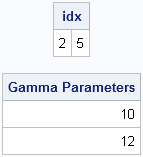
When you create a character matrix in SAS/IML software, the initial values determine the number of characters that can fit into any element of the matrix. For example, the following statements define a 1x3 character matrix: proc iml; m = {"Low" "Med" "High"}; After the matrix is defined, at most










